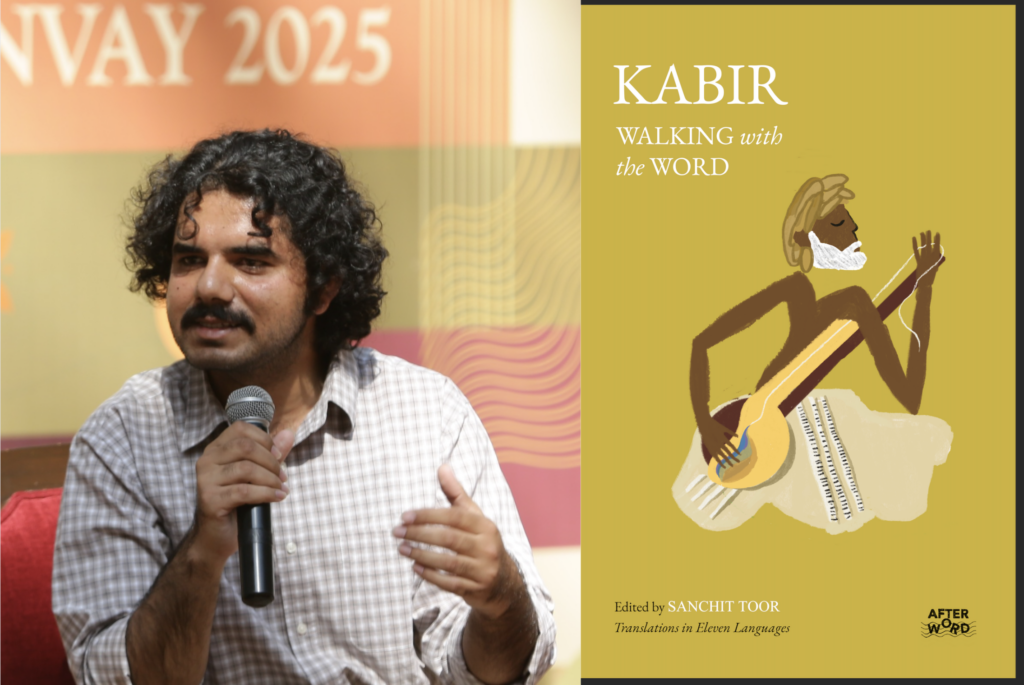
Sanchit Toor on Editing ‘Kabir: Walking with the Word’ and the Importance of Translation

The popularity of the north Indian saint-poet Kabir (1398-1518) among the English reading public owes a great deal to translation. His poetry, which is available in Khadi Boli, Bhojpuri, Brajbhasha, Marwari, Awadhi, Kutchi, Malwi, Punjabi, and many other languages—thanks to oral traditions of folk and classical music, apart from books—has travelled far and wide due to the labor and ingenuity of several generations of translators. These include Kshitimohan Sen, Rabindranath Tagore, Linda Hess, Shukdev Singh, Vinay Dharwadker, Arvind Krishna Mehrotra, and more.
My immersion in Kabir’s poetry owes much to the year (2010-2011) that I spent working with filmmaker Shabnam Virmani, founder of the Kabir Project at the Srishti Institute of Art, Design and Technology in Bengaluru. The project was born in response to the 2002 Gujarat riots, which led to a crisis of meaning for Virmani, who sought comfort and wisdom in Kabir’s words. She travelled to Rajasthan, Madhya Pradesh, Kutch, Pakistan, and the United States in search of peers and contemporaries who swear by Kabir’s call to give up bigotry and look within.
My work with the Kabir Project involved developing ideas and programs with schools, colleges, and universities around Virmani’s films on Kabir, as well as live music performances and talks. I got to interact closely with singers and also conducted workshops with students and teachers. This experience also nurtured my journey as a peacebuilder, who later ran an initiative called Friendships Across Borders: Aao Dosti Karein to bridge divides between Indians and Pakistanis.
Kabir: Walking with the Word, a volume edited by Sanchit Toor and published by AfterWord (an imprint of Tethys Books) in collaboration with the Ashoka Centre for Translation, is a welcome addition to the body of Kabir translations that are available to contemporary readers. The first half of the book features translations of six of Kabir’s poems in 11 languages by Aditya Korrapati (Telugu), Anisur Rahman (Urdu), Kaladhar Mutwa (Sindhi), Kamalakar Bhat (Kannada), Paridhi David Massey (Persian), Prashant Ingole (Marathi), Prathik Murali (Tamil), Pratishtha Pandya (Gujarati), Sowmya Dechamma CC (Kodava), Suchismita Ghosh (Bengali), and Sanchit Toor (English). It is an astute selection, emphasizing Kabir’s spiritual quest and his invitation to prioritize our shared humanity over divisive religious and caste-based identities.
For instance, a stanza of one of the poems translated by Toor reads thus:
“One wind, one water.
The universe lit up by one light.
All pots made of one earth.
One maker in sight.”
The pot is a recurrent metaphor in Kabir’s poetry, and it usually denotes the perishable human body. Kabir proposes that all human beings are creations of the same creator, just as different pots are fashioned out of the same earth. This analogy is a call for harmonious coexistence.
The second half of Kabir: Walking with the Word features essays by scholars Gogu Shyamala (“Equality, Love and Harmony: Kabir, Vemana and Ambedkar”), Nitya Pawar (“Naam-Smarana: A Case of Translating the Untranslatable), and Prathik Murali (“Kabir Ennum Kattatanka Tiraikatal: A Note in Tamil), along with musician Shruthi Veena Vishwanathan (“My Body, the Tambura: Inhabiting Kabir in the Breath and the Body”). Unnati Chaudhary’s minimalist illustrations are scattered across the book. These are black and white sketches that draw our attention to recurring images in Kabir’s poetry, such as a swan, a tambura, a loom, and a fish.
Toor is a multilingual researcher-translator and Project Coordinator at the Ashoka Centre for Translation, Ashoka University, India. He grew up in a village near the city of Panipat (in Haryana, a state in India), which the family later moved to because of his father’s work. He got himself a college degree in neuroscience, hoping to become a neurolinguist in the future, but ended up being drawn to literature and translation. He learnt folk songs in Haryanvi from his mother and grandmother, and the Gurmukhi script from his grandfather. The latter enabled him to explore Punjabi literature. He has developed an ear for various north Indian languages and dialects through close listening.
Today, he works with languages such as Hindi, Haryanvi, Brajbhasha, and Punjabi, and is interested in the early modern and modern literary, religious, and cultural communities in North India. He has been a Visiting Faculty of Haryanvi and Brajbhasha at Ashoka University and has translated Haryanvi women’s folk and devotional songs through the Sahapedia-UNESCO Fellowship. He enjoys accessing literature through the medium of song because that allows him to sing along and retain it well in his memory.
Here are some excerpts from an interview with him.
Chintan Girish Modi: When and how were you introduced to the poetry of Kabir?
Sanchit Toor: My first conscious introduction to Kabir, like most of us in the Hindi-reading sphere, happened through his dohas (couplets) included in the school textbooks. I enjoyed reading and reciting Kabir’s poetry in its ‘mixed’ original as I did Ravidas’s, Rahim’s, Sur’s, and even Lal Ded’s.
In parallel was another lifeworld—although I’d come to make sense of it later—in which Kabir featured not as the poet but as the ultimate divine. Unlike my mother, who came from a goddess-worshipping family and was married into one, my mausi (maternal aunt) was married into a Kabirpanthi community that largely practiced “non-caste Hinduism”.
Growing up in rural Haryana, where local saints often invite more sustained devotion than gods and goddesses, I would visit the Kabir panth (sect) with my cousins as a youngster. But my focused return to Kabir’s words happened as a university student. While I was studying the sciences, encountering the long trail of progressive singers and scholars of Kabir, such as Shabnam Virmani and Linda Hess (not to mention my emails to them and their kind responses), would reorient me to the world—Kabir’s and my own, literary and otherwise.
I would eventually come to find and follow the words of Kabir in the Guru Granth Sahib as well as in my own family.
CGM: What do you make of the various layers of social, political, religious, and spiritual meaning that have accumulated around Kabir, who has grown into more than a poet?
ST: Kabir has always been seen as more than a poet, for he is. We might call him a ‘saint-poet’ or, say, ‘poet-philosopher’ as Purushottam Agrawal rightly does (in his 2021 book Kabir, Kabir: The Life and Work of the Early Modern Poet-Philosopher). Somewhere, he is ‘Sant’ Kabir, the saint; elsewhere, he is ‘Bhagat’ Kabir, the devotee; and for my mausi, he is Kabir ‘Saheb’, the master. His name, signature, image, and poetry have continuously been recontextualized in not only the oral tradition but also the textual tradition.
What might appear as ‘contradictions’ in the practices of the Kabirpanthi communities to a ‘liberal’ mind (as they once did to me)—such as my mausi bowing down to the idol of Kabir or lighting a lamp in front of an image of Kabir, an iconoclast—are no contradictions as you pay equal attention to the life of Kabir’s poetry and the community together. There is a layered complexity, yet conceptual clarity in Kabir’s oeuvre, as is in the practicing community’s manifesto.
That clarity of Kabir’s is partly a poet’s clarity. He is a brilliant poet. He knows well how to land a blow on our illusioned senses, how to shake the ground we stand on. To that end, his critique of the unequal social order, institutionalized beliefs, and the worldly human condition stems as much from his bhakti (devotion) as from his own social and temporal locations. In the same breath, he can submit to his nirgun (without attributes of form or others) Ram as a ‘slave’ and claim that Ram, too, must be after him, chanting ‘Kabir, Kabir’.
CGM: How did you conceive and develop the volume Kabir: Walking with the Word?
ST: When I joined the MA program in English at Ashoka University in 2020, I read for a graduate course in ‘Translation Theories and Multilingual Contexts’ in my first semester. The instructor, Professor Rita Kothari, invited me to present with her in a class on Kabir and the Sindhi Sufi poet Shah Abdul Latif. She had accessed a copy of Sindhi translations of Kabir’s dohas. That conversation, in which we moved between translational exchanges in both textual and oral spheres, is where the seed perhaps germinated.
Later, in early 2022, I wrote my thesis under her guidance on English translations of Kabir, and the idea of ‘walking with the word’ got rooted in me. Not too long before, in December 2021, I was also involved in setting up the Ashoka Centre for Translation with the directors, Professors Rita Kothari and Arunava Sinha. Together, we conceptualized ‘Translating Bhakti’ as a pilot project full of exceptional possibilities. If I could read (and memorize for the rest of my life) Lal Ded’s Kashmiri vakhs in Hindi, maybe one could do it in other languages, too.
Kabir’s poetry already comes to us carrying resonances of the source registers—you can hear his ‘pure’ Bhojpuri compositions on the one hand and confuse his verses included in the Guru Granth Sahib with those of the Sikh gurus on the other. There is a sharedness between Indian languages that translating devotional vocabulary introduces us to, for most regions have seen progressive, revolutionary trends within the sphere of devotion. This is the tradition Kabir also inherits and furthers, and we wanted to locate him once again in this multilingual ethos of India.
Kabir: Walking with the Word is certainly not the first or last such experiment; it is also small in scope but a deeply fulfilling one.
CGM: Based on what criteria did you select the six poems that were translated into 11 languages?
ST: Once we conceptualized the idea, we put together a list of ten poems to be translated. The criteria were to include those poems that circulate in the popular domain, with each poem representative of Kabir’s overall force with its specificity of theme. We wanted to reach as many Indian languages as possible. We invited some terrific poets and translators to join us for a conversation—a satsang, as we called it. And it is to their credit that this book was possible, given their engagement with Kabir in varying intimacies.
I would hesitate to speak too much on the book’s behalf as I did while writing the very brief introductory note. The book, in some ways, determined its own shape.
We began with ten poems, and while several receiving languages made space for Kabir’s upside-down register with ease, English struggled the most with his yogic framings. Tasked with attempting the English translations, I not only hesitated but also failed. We settled with the final six that offered us at once six images and one whole image of Kabir—from his love for Ram to his candid attack on caste.
Some translators managed to accommodate his ideas using the same words as the source poems, while others coined or borrowed new equivalent words or forms—such as Narsinh Mehta’s while translating into Gujarati, Shishunala Sharif’s while translating into Kannada, and Tukaram’s while translating into Marathi. Working on this volume offered the translators and us a lot in terms of both the successes and failures of translation. The translated texts speak for themselves as opposed to a paratextual, detailed introduction or commentary, which we decided against.
I’d rather these translated poems be set loose in the world. I hope others pay attention to their triumphs and limits and set them to new registers and rhythms, as people in the past would have.
CGM: Could you talk about the politics driving this translation project and why it was important for you to work on this?
ST: Once you involve language at the center of things, it comes to signify a lot more than itself. First, this project is located squarely within a many-to-many framework that we are aiming for at the Centre. We want to translate from many languages into many languages to explore the language dynamics of this multilingual nation and situate our translational inquiries and responses in it. So, a politics of language can be observed in this translation project.
You will find Gujarati and Sindhi texts next to each other on the page, as are Gujarat and Sindh in geography. The Kodava translation uses the metre of the Kannada translation but not its script. The Urdu translation welcomes Kabir in a ghazal-like form but relies heavily on the phrases of the original ‘early Hindi’. Then, there is the second emphasis for us: a commitment to the exchanges between thoughts, ideas, languages, and figures.
The ‘Translating Bhakti’ project interests us precisely because it shows us how much we already do or can share. There is a democratic ideal that translation signifies for us, especially in this project. It is laid out critically in some places (like in the essays that link Kabir’s message with other spiritual and pragmatic lifeworlds in Tamil, Telugu, Marathi, etc.), and you have to find it in the small creative acts of translation in others (the Persian translator saw reflections of the poet Hafez while translating Kabir).
Kabir’s words have echoed with force across times, and they offer as urgent a praxis today as they did back then. And, as Shruthi Veena Vishwanath’s essay in the book argues, taking them on the tongue is not enough; you have to take them in the breath and the body.
CGM: How did your relationship with and understanding of Kabir grow through the process of putting together this volume, especially with Gogu Shyamala and Nitya Pawar’s essays that look at the resonances between Kabir and other important political and cultural figures such as Ambedkar and Janabai?
ST: This volume is phenomenal because it has taken us far and wide in thought despite its limited scope. I say that translation is “the fact and the faith” of this multilingual book. It managed to map many resonances, literary and beyond, allowing us to walk with many figures who have walked with Kabir in their ways. Their spring, as I note in passing, “echoes of existing histories or promises of new ones”.
Dr Gogu Shyamala’s brief essay, “Equality, Love, and Harmony: Kabir, Vemana, and Ambedkar”, takes us to the Telugu poet-philosopher Yogi Vemana and Dr B.R. Ambedkar via Kabir, reminding us that “Kabir’s is the religion of love”. As she emphasizes through Ambedkar, any spiritual praxis must be subjected to the yardstick of social justice, where Kabir and his other nirguni companions fare really well.
Often, the saguni (dedicated to a divine with attributes) saint-poets are not too far behind either, as Nitya Pawar’s research essay, “Naam-Smarana: A Case of Translating the Untranslatable”, brings forth. Pawar’s essay—based on a popularly told story of a meeting between Kabir and the Varkari saint-poetess from Maharashtra, Janabai, who lived before Kabir—critically engages with an intertextuality of narratives and images. Kabir and the question of gender [his attitudes towards women and potential blind spots] are often discussed by readers and scholars alike. And through Pawar’s essay, through Janabai’s witty spontaneity, we learn as much of gendered labour as we do of love for the divine’s name.
My relationship with and understanding of Kabir has grown exponentially with each translation choice the translators made, each link between ideas and lives the essay writers recorded, and each illustration (or intersemiotic translation) the illustrator rendered.
CGM: The Indian publishing industry tends to focus on single-language translations rather than books like this one with multiple languages. What sort of support did you receive from Tethys Books and the Ashoka Centre for Translation for such an experimental anthology?
ST: At the Centre, we were not sure from the start what kind of published shape the project would take. Some of the translators had translated and recorded their translations in voice. It was important for me to hear the sounds of each language, the rhythms of each poem, for I do not know all the languages included here, although I share varying familiarity with most of them. The translations happened at different paces and times—not to mention the many delays that I, as the editor, brought in, which is why I must repeatedly emphasize that it is the contributors who have made this experiment a real success.
We thought we might release the translations as a pamphlet. We also considered the possibility of doing an audio version, either entirely or in parallel (and we still might). This is, on all fronts, a project made possible by the Ashoka Centre for Translation, which is my intellectual and professional home. The contributors trusted the Centre, and in the process of putting this together on behalf of the Centre, I believe that I managed to win their faith, too.
Tethys Books stepped in to print the book under their new translation-focused imprint called AfterWord, for which they deserve our immense thanks. You are right, and we were aware that this was no commercial project for any general publisher to show interest in. After all, we offer all texts (including an entire essay) in the languages’ respective scripts with no transliterations provided. That is indeed a choice we made: to set a standard for ourselves of envisioning more and perhaps bigger projects of this kind in the future, wherein difference is celebrated in its very essence.
We only hope more space can be made available for such experiments, where unfamiliarity (or even the concept of untranslatability) is seen not as a deterring lack but as an opportunity to travel across to the other.





